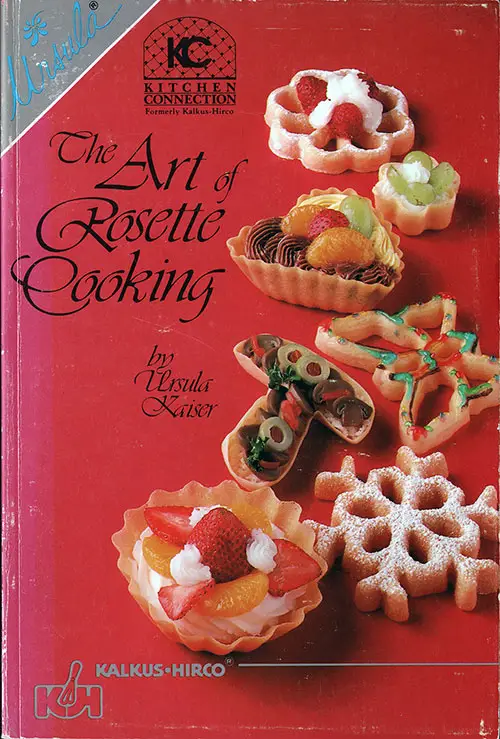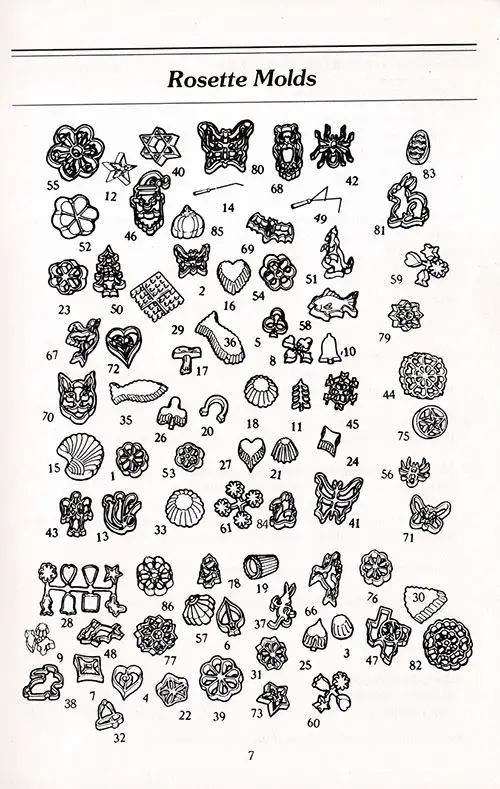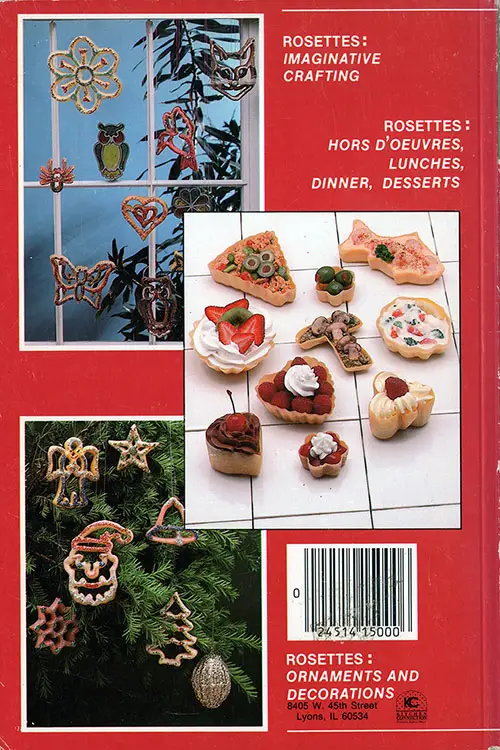The Art of Rosette Cooking – Traditional Pastry Making and Family Rituals in Cultural History

Front Cover, The Art of Rosette Cooking by Ursula Kaiser, n.d., Kalkus-Hirco, Lyons, Illinois, Soft Cover, 89 Pages. | GGA Image ID # 1d8df30f0d. Out of Print.
🌍 Introduction: From Iron Age Pastries to Transatlantic Kitchens
Ursula Kaiser’s The Art of Rosette Cooking (Kalkus-Hirco, c.1960) is more than just a recipe booklet—it's a culinary time capsule that bridges ancient tradition with 20th-century American domestic life. Though not directly related to ocean liners like the RMS Titanic, this book has deep cultural significance for understanding the kinds of recipes and cooking rituals that immigrant families, stewards, and ocean travelers may have brought with them or experienced at sea—particularly among Scandinavian, German, and Eastern European communities.
For teachers, students, genealogists, and cultural historians, this page on the GG Archives presents a valuable archival listing that can spark exploration into ethnic foodways, kitchen tools, and holiday cooking customs that mirror experiences aboard ships or in immigrant households.
Instructions and History of Rosettes
An ancient pastry-making tradition dating back to the Iron Age has been revived in a new line of products from Kalkus-Hirco, Inc. It's a collection of 81 different pastry shell molds called Rosette Irons that make everything from party cookies to gourmet entrees.
These Rosette Irons are not just tools; they're a source of joy and excitement in the kitchen. They're easy to use, inexpensive to buy, and they can turn simple ingredients into unusual, tantalizing meals and treats. With just one cup of flour, one cup of milk, and one egg, you can make 50 pastry shells. And the best part? They provide endless kitchen fun for the whole family.
The Pastry is formed by dipping molds into a special batter and then deep-frying it to a crisp, flaky texture. The Rosette name originates from the basic geometric shape of the oldest mold — a circle crisscrossed with arcs to form a flower-like pattern.
The famous Rose Window in the Notre Dame Cathedral is in the shape of a rosette. It was a very popular shape in the early days of iron moldings. This shape was used to decorate gates, buildings, furniture, and especially festive foods.
While Rosette Irons takes their name from one shape, many other traditional shapes are associated with different European Countries. For centuries, Italian cooks have used a large bowl-shaped mold called a Timbale. Flat irons called waffles have long been popular in Germany. In America, these pastry molds are most familiar to the descendants of Scandinavian Families who call them simply "rosettes."
The Christmas Season was the time when Norwegian grandmothers would perform a kitchen ritual that the children loved. First, a simple batter was made with flour, eggs, sugar, salt, and a little vanilla for flavor. Then the oil was heated in a deep pan, and the magic began.
The process of making rosettes is a delightful ritual. A rosette iron, attached to a long handle, is dipped into the oil to preheat. Then, it's dropped into the batter, ensuring none spills over. In a few seconds, the iron is removed, and the batter perfectly clings to the shape.
The batter and iron were then dipped into the hot oil. In a few more seconds, the rosette molds turned golden brown. Then out they came with a pair of tongs to drain and cool on a paper towel. With a bit of powdered sugar sprinkled on top, they were terrific!
But most grandmothers added a few more finishing touches, usually chocolate chips or a sugar glaze frosting.
Using Rosette Irons is not just about making delicious pastries; it's about creating lasting memories. Everyone in the family can take a turn at making some rosettes, and the joy of the process is often as sweet as the treats themselves.
Now every American family can share in this type of holiday fun and lots more. With 81 different molds and dozens of recipes, iron pastries fit into almost every mealtime and entertainment occasion.
Consider the versatility of Rosette Irons. Their various shapes can be used to create a wide range of dishes. They can be filled with fresh fruit, fruit fillings, and puddings for a delightful dessert, or they can transform leftovers into creative new entrees.
Our fish molds make perfect serving shells for a seafood casserole. With dozens of different molds and irons in our collection, we can create wonderful treats for every holiday and special occasion.
There are bridge molds, mushrooms, stars for hors d'oeuvres, deep shells for creamed meats and puddings, and even a mold for ice cream cones. Using the Cartwheel Tidbit Maker, it's possible to make six dozen cookies in about half an hour.
Today, the foods one can make with Rosette Irons are limited only by the imagination. There are a few tricks that can turn rosette iron pastry making into works of art.
For example, after the batter is formed and before it cools, it's possible to bend it. You might take the butterfly shape and bend the wings up to make a butterfly that looks as though it's flying.
You can also add a few drops of food coloring to the top of the batter in the bowl. Don't stir. Just swirl lightly around the top. Now, when the irons are dipped, colors will swirl through the Pastry.
Rosette Irons are easy to use, inexpensive, versatile, and a great source of family fun. All pastries can be made ahead and stored in an airtight container for up to 6 months or frozen.
At room temperature, they will last about one week in a cookie jar. The molds are easy to use, and children can even work with them if properly supervised.
For our purposes, these irons can be divided into two types: the decorative ones and the shells. The shells are the Patty Shell, Sea Shell, Deep Heart Shell, Mushroom Shell, Deep Tart Shell, Ice Cream Cone Shell, and Petite Shell.
All of these can be filled and used for appetizers, vegetables, main courses, or desserts. The rest of the irons are the decorative ones. These are used as chips for dips, and when sprinkled with powdered sugar, they make dessert cookies.
Rosette Molds

A Lot of Different Rosette Molds Are Available. You’ll Have Many Options for That Perfect Shape That You’re Looking For. Art of Rosette Cooking, circa 1960. | GGA Image ID # 228a4d27d8
HEAVY BATTER
Bear 2 eggs
add 1 cup evaporated mük or half & half
Mix all ingredients with wire whisk, in blender, or food processor. Batter will be smooth and creamy. Refrigerate or let stand for 1/2 hour.
Assemble utensils:
- deep fry unit
- Thermometer
- paper towels tongs
(Instructions for making Heavy Batter continued)
- Heat oil to 365°
- Heat Patty Shell iron #3 by dipping utensil into oil (20 sec.)
- Drain slightly on paper towel to remove excess.
- Dip hot iron into batter (DO NOT get batter on top of mold).
- Dip mold into hot oil (rest on bottom of pan to insure flat bottom).
- As patty browns gently lift mold away, patty will drop into hot fat.
- When patty is browned on one side, tum to brown on the other.
- Remove from oil and drain on paper towel.
- Repeat — heating iron, draining, and dipping into batter.

Back Cover, The Art of Rosette Cooking. | GGA Image ID # 1d8e35adf7
Contents:
- History
- Instructions
- Rosette Molds
- Batters
- Breakfast Treats
- Appetizers and Snacks
- Dips or Fillings
- Dinner or Lunch
- Desserts
- Cookie Recipes
- Craft Ideas for Rosette Ornaments
- Krimp Kut Sealer
- Tart Master
- Tart - Turnover - Ravioli - Fried Pies - Filled Cookies
General Instructions and Important Hints
Cooking Utensils:
- An electric controlled pan is recommended (350°—375°).
- The pan should be deep enough to allow mold to be completely submerged.
- Use a small deep pan for deep molds, you will use less oil.
- Use a thermometer to check degrees, even when using electric pans. (350°—375°) 1" cube bread browns in one minute.
Oils: Any good quality cooking oil.
- 1. Peanut Oil and Safflower Oil have less calories.
- Heat oil to 365° before dipping shells or molds.
- Keep temperature at 350°—375°; if temperature is too low, pastry gets soggy and greasy. (Use thermometer to test: 1" cube bread browns in one minute.)
Molds:
- Preheat molds about 10 seconds.
- Drain slightly on paper toweling before dipping into batter.
- Keep molds free from crumbs and bits of batter.
- No batter should be on top of mold.
- Dip batter-filled mold into hot oil and submerge for quick second before releasing.
- Use fork tine or tongs for turning; be careful not to prick.
- Allow deep molds to rest on bottom of pan for a second to insure flat surface.
- Wash molds with detergent after each use to keep from becoming rancid.
Batter:
- Mix batters by hand, with wire whisk in order given, alternating dry with moist ingredients.
- Use food processor with steel blade or blender.
- Batter should be free of lumps and creamlike in texture.
- Let stand 30 minutes to allow bubbles to disappear or make the night before and refrigerate.
- Cold batter gives crispier, thinner pastry. (Store in covered container.)
- Use cake flour sifted 3 times for lighter, more delicate crust.
- Do not use self rising flour.
- Add color (red—green) for tinted shells.
- Evaporated milk produces heavier batter than regular milk.
- Add cornstarch for a heavier shell. (Meat dishes with sauce).
- Replacing beer for the liquid in recipe produces a more flaky pastry.
- Add spices & Flavorings to suit taste to basic recipe:
For LEMON COOKIES
- 2 tbl. lemon juice, 2 tbl. sugar
For CHOCOLATE WAFFLE
- 2 tbl cocoa, 2 tbl. sugar
- Substitute 3 tbl. Kahlua or liquor for milk.
Spice batter
- 1/2 tsp. vanilla, 1 tsp. nutmeg, 1 tsp. cinnamon, and 1/2 tsp. ground ginger
- Add 1/4 cup finely chopped nuts or fruits to batter.
Substitute liquid for liquid, flour for flour, keeping in mind: 1 cup DRY does not equal 1 cup LIQUID i.e. 1/2 cup flour + 1/2 cup com meal = 1 cup FLOUR; 1/2 cup milk + 1/2 cup half & half = 1 cup MILK
Heavier flour (i.e. cornstarch) shells are firmer.
For richer, crispier pastry, add an extra egg to basic batter.
STORAGE HINTS
- Cool and drain completely before storing.
Will keep 6 months stored fresh in air-tight container.
Will keep 6 months if frozen. - Freeze individual shells on cookie sheet. When frozen, stack in container (plastic box prevents breakage).
- To warm: Place in 350° oven on cookie sheet — 5 minutes. (Place in microwave 10 seconds.)
Now that we have had all the general information, let's begin to have some fun.
Kalkus-Hirco, 1960. "Ursula Kaiser, owner of Kalkus-Hirco, Inc. is sharing with you, in this her first volume, some of her recipes and hints on how to have fun in your kitchen using the Kalkus-Hirco Rosette irons; Tartmaster and Krimput Sealer.
Her enthusiasm for fine dining pleasures reaches all ethnic groups. The many shapes and designs of the Kalkus-Hirco rosette irons, seasoned with the variety of batter recipes, opens the door to endless culinary creations for you, your family and guests to enjoy." Scarce, Out Of Print, Book. . Soft Cover. Very Good. 6 x 8.75 in., 89 Pages.
This is a complete guide on rosette cooking -- history -- molds are shown (line drawings) -- there are 33 batter recipes -- recipes using the rosettes -- craft ideas for rosette ornaments.
✨ Highlights: Why This Book Matters for Historical and Cultural Study
🍩 1. Rosettes as Cultural Artifacts
Rosette pastries—deep-fried, flower-like confections—have been linked to ancient Europe, including Scandinavia, Germany, and Italy. This book traces how these designs evolved from architectural motifs like Notre Dame’s rose window to decorative pastry molds. These edible designs reflect the transmission of tradition, much like language or embroidery patterns.
🛳️ 2. Relevance to Ocean Travel
While rosettes themselves weren’t baked aboard the Titanic, immigrant families—especially Scandinavian-Americans—carried these traditions across the Atlantic. Their stories are embedded in family rituals, many of which took place soon after arrival or were revived in festive gatherings. Stewards and cooks aboard transatlantic liners often prepared ethnic foods for second- and third-class passengers, particularly during holiday voyages.
👨👩👧 3. Family Participation and Multi-Generational Learning
The book beautifully emphasizes family kitchen rituals. Norwegian grandmothers would delight children with the sizzling magic of rosette making—a scene evocative of the tight-knit immigrant households that developed post-migration. These kitchen activities mirror the community-building that took place aboard emigrant ships or in ethnic enclaves in New York, Chicago, and beyond.
🎨 4. Versatility of Rosette Irons
With over 81 different molds, the book illustrates how one simple tool evolved into a modular platform for edible art:
🐟 Fish molds for seafood casseroles
⭐ Stars and bridges for hors d’oeuvres
🍦 Ice cream cone shells
🧁 Petite molds for puddings and tarts
This innovation recalls the culinary creativity of transatlantic chefs tasked with making limited ingredients stretch into artful presentations—especially in second-class galleys or officers’ messes.
🖼️ Noteworthy Images
📕 Front Cover – The Art of Rosette Cooking
An inviting image that sets a nostalgic, mid-century tone, suggesting a homemade culinary heritage accessible to everyday families.
📘 Back Cover – Detailed Table of Contents
With sections like “Craft Ideas for Rosette Ornaments,” “Tart Turnover Fried Pies,” and “Krimp Kut Sealer,” the book reflects practicality and creativity, allowing students to explore culinary history as hands-on material culture.
📖 Educational Value for Specific Audiences
Audience: Relevance
🧑🏫 Teachers: Excellent source for home economics, ethnic studies, or immigrant food culture. Rosettes make a great subject for interdisciplinary projects involving art, history, and food.
✍️ Studen:ts Use this as a primary source when writing about immigration-era food traditions, or the role of women and children in preserving cultural identity through cooking.
📜 Genealogists: Connects with Scandinavian and German-American family rituals. Helps contextualize heirloom tools or oral history references to “holiday baking” and “grandmother’s cookies.”
🛳️ Maritime Historia:ns A supplementary lens on shipboard domestic life, especially for immigrant passages. Cooking tools like these may have had equivalents in galley equipment or family baggage.
✅ Final Thoughts
The Art of Rosette Cooking preserves more than pastry techniques—it celebrates intergenerational knowledge, ethnic identity, and the quiet joy of hands-on tradition. Though it may not have traveled aboard the RMS Titanic, its themes—homemaking, festivity, adaptability—are deeply tied to the cultural values of those who did.
📚 Students and researchers: let this book inspire essays on cultural continuity, culinary creativity, and the rituals that sustain us across oceans and generations.
GG Archives is proud to preserve its memory—and so can you. 🍩✨
